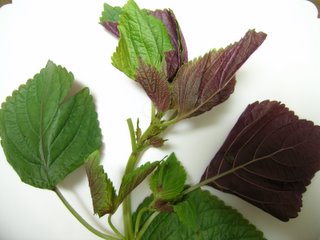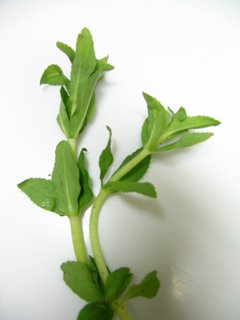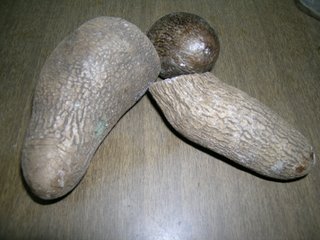Vietnamese dishes heavily depend on the use of fresh herbs. Unlike most western traditions where herbs are only used in relatively small amounts to add flavor; Vietnamese people consume their herbs in high amounts as if they were veggies. At many Vietnamese tables, there is sure to be an abundance of fresh mixed herbs on table to compliment the meal. There are certain herbs that only go with certain dishes. However, most of the herbs are for “general use” (i.e. in almost all noodle dishes and spring rolls).
General Use Herbs:

Uses: with noodles and wraps and in some salads.
Uses: with noodles and wraps and in some salads.

Widely used in almost every dish.
Herbs Used Only for Certain Dishes:


Veggies:
Usually shredded and used in salads or with certain noodle dishes. After shredded, always soak in acidified water (1 tbs "acid" i.e. vinegar, lime/lemon juice, etc….) to keep from browning. Drain just before serving.
**More to come (as soon as I can get their pictures).
General Use Herbs:
Vấp Cá, Dấp Cá, Houttuynia cordata Thunb.
Widely used in dishes from the southern regions of Vietnam

Tía Tô, Perilla frutescens (L.) Britt.
A must have for making bì cuốn spring rolls. The leaves are green on one side and purplish on the other. Uses: with noodles and wraps and in some salads. Uses: with noodles and wraps and in some salads.
Uses: with noodles and wraps and in some salads.

Rau Răm, Vietnamese Cilantro, Laksa Leaves, Polygonum odoratum Lour.
Unique somewhat spicy flavor. Widely used in salads, served with balut, in noodles and wraps.One of the more well known herbs. Widely used in salads, noodles and wraps.
Herbs Used Only for Certain Dishes:

Ngò Om, Rau Om, Rice Patty Herb, Limnophila aromatica [Lomk.] Merril
Flavor is similar to cumin, only used in soups such as canh chua (sour soup) and canh khoai mở (potato soup).
Ngò Gai, Saw-tooth Herb, Eryngium foetidum
Flavor is similar to cilantro but with a twist. Only used in same soups as ngò om, and phở (beef noodle soup), and some salads. Used to make bò cuốn là lốt, or canh bò lá lốt.
Veggies:
Usually shredded and used in salads or with certain noodle dishes. After shredded, always soak in acidified water (1 tbs "acid" i.e. vinegar, lime/lemon juice, etc….) to keep from browning. Drain just before serving.
The only english translation I've come across for this veggie is taro stem. The problem is it does not come from taro but a plant from the taro family. Used to make canh chua, in stir fries, and salads.
 Khoai Mở, "Chinese Yam"
Khoai Mở, "Chinese Yam"
 Khoai Mở, "Chinese Yam"
Khoai Mở, "Chinese Yam"**More to come (as soon as I can get their pictures).
6:12 PM |
Category: |
12
comments
















Comments (12)
1: bac ha (southern) = doc mung (north)
2: no bac ha is not a southern word for hung. bac ha has 2 meanings, it can either mean mint flavoring or "taro stem" (pictured). Bac ha only means mint when you're using it to discribe mint flavoring in something. For example, keo bac ha (mint candy), siro bac ha (mint syurp), dau/mui bac ha (mint oil/flavoring). If you're talking about mint (the actual herb) you would call it rau hung cay or rau hung lui but never rau bac ha (no such thing as rau bac ha). On the hand, if you just say "bac ha" it implies you're talking about the "taro stem" (aka doc mung in the north). In a nut shell,...When there is an adjective, bac ha means mint flavoring, bac ha alone (w/out an adjective) means taro stem, mint herb is called rau hung.
3: Rau thom is a general term that means herbs. La que is a type of rau thom. Thus, la que is not the nothern word for rau thom.
Hi Hoang,
Thanks for posting your knowledge Vietnamese on herbs. The Vietnamese names,scientific names, and pictures are very helpful because I'm thinking of growing them myself since I can't get them easily in Cedar Falls, IA.
You must be from the South (and that's good for me, b/c I can't understand the Northern dialect). Please add more. Keep up the good work!
Tham
Dear Hoang,
I came across your great blog by googling for a "steamed rice pie" -- that is a savory dish made of layers of rice flour, steamed. Very similar to the crepes recipe with pork belly and bean sprouts. However, I don't see the recipe that I am searching for, would you know the name of it?
Also, your herbs section is excellent and I'm so thrilled to find the other authentic recipes. These are fantastic. Thank you!
Thanks for stopping by.
steamed rice pie doesn't ring a bell.
can you describe it more?
Hi Hoangtam,
Found your website last week. I'm so glad that your recipe are all in english. Thanks. I've tried banh beo and banh bo hap and it turns out o.k.
I saw a chef in Syndney cooking canh chua and he calls bac ha as elephant ear stem.
I went to a restaurant and had
Cai Xanh Xao Rau Que (basil vegetables) and would love to find the recipe but I cannot find the term! thanks
sharon
Hi TT, seems like you were unsure of the "doc mung" English translation. It is indeed taro stem and belongs to the "elephant ear" plant family, hence the translation from the Aus chef. Good work so far with Vietnamese cuisine and I hope I'll see more of you.
Hi
do you happen to know where they sell the lolot piper (lá lốt) seeds? I've been looking forever but they only sell the whole plant. thanks
Hi, just to let you know bac ha is green brier.
@LyNn
I just happened to have cloned lalot_betel
plant using cutterings as well as layerings
both work well in south Paris (45° latitude)
Hi Hoang,
Thanks for all the information. My wife is Vietnamese and uses most of these herbs when cooking. I want to try and grow some of them but she did not know the names of the herbs in English. Now we can hopefully buy them in pots and plant them.
Thanks again
Peter.
Thanks again.
Hi Peter,
you can easily find most of these herbs at any Asian grocery store.
And! they root really easily. Just put the stems in a glass of water in a bright location. Within a few weeks you should see roots stick out of the stems. Pot them up or plant the in the ground. Simple as that!